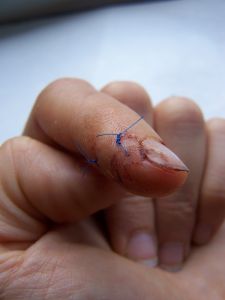There is a lot of work that goes into setting up a major event like the Super Bowl and that means a lot of workers are on hand. With such a large production, it is an unfortunate reality that some of those workers will be injured. Tragically, it is being reported that a worker hired to help set up a large stage outside the stadium was killed on the job.
 The stage was located outside of University of Phoenix Stadium, and was being built to host the NFL Tailgate Party. The victim was a rigger, which is an employee hired to move large object high above street level.
The stage was located outside of University of Phoenix Stadium, and was being built to host the NFL Tailgate Party. The victim was a rigger, which is an employee hired to move large object high above street level.
Witness say the worker was on a tower being constructed to hold up the stage when he fell approximately 25 feet. He was severely injured during the fall and required immediate medical attention. First responders arrived and provided initial treatment and transported the 31-year-old victim to a local hospital. However, doctors pronounced him dead shortly after arrival at the hospital.
Continue reading
 Massachusetts Workers Compensation Lawyers Blog
Massachusetts Workers Compensation Lawyers Blog




 First it is important to understand what it is like for someone who suffers from carpal tunnel syndrome. A CTS victim, whether an office worker, retail employee, or trade worker, spends most of their day trying to ignore the tingling and numbness in their hands and wrist. This can become extremely painful and made worse by repetitive movements a worker is required to make throughout the workday.
First it is important to understand what it is like for someone who suffers from carpal tunnel syndrome. A CTS victim, whether an office worker, retail employee, or trade worker, spends most of their day trying to ignore the tingling and numbness in their hands and wrist. This can become extremely painful and made worse by repetitive movements a worker is required to make throughout the workday. In 2012, she filed a claim before the workers’ compensation commission requesting insurance company be found liable for claimant’s medical expenses. The following year, insurance company agreed to liability and entered into a settlement agreement to pay for medical expenses.
In 2012, she filed a claim before the workers’ compensation commission requesting insurance company be found liable for claimant’s medical expenses. The following year, insurance company agreed to liability and entered into a settlement agreement to pay for medical expenses. Prior to becoming ill, claimant had accrued around 6,000 hours of paid sick leave. His employer paid out his sick leave prior to retirement in the amount of approximately $40,000. This sick leave payout was roughly equivalent to his annual salary. He used the balance of his sick leave, as permitted, to earn another year of employment credit with respect to his retirement plan.
Prior to becoming ill, claimant had accrued around 6,000 hours of paid sick leave. His employer paid out his sick leave prior to retirement in the amount of approximately $40,000. This sick leave payout was roughly equivalent to his annual salary. He used the balance of his sick leave, as permitted, to earn another year of employment credit with respect to his retirement plan. In 2003, claimant returned to the school system, and his second day back on the job, two students he refused to let into the classroom due their disruptive behavior assaulted him. His specific claim was that one student injured his shoulder when he pushed claimant into the doorframe to get past him. He also alleged one student continued to the threaten him and told claimant “[he] was going to put a put a cap in his ass.” The other students repeatedly mocked claimant for the remainder of the day, making teaching virtually impossible. Claimant never returned to teach at the school.
In 2003, claimant returned to the school system, and his second day back on the job, two students he refused to let into the classroom due their disruptive behavior assaulted him. His specific claim was that one student injured his shoulder when he pushed claimant into the doorframe to get past him. He also alleged one student continued to the threaten him and told claimant “[he] was going to put a put a cap in his ass.” The other students repeatedly mocked claimant for the remainder of the day, making teaching virtually impossible. Claimant never returned to teach at the school. While driving, claimant was struck from behind by a shovel bucket of another huge piece of mining equipment. According to court records, the shovel bucket was large enough to hold an automobile. It hit the rack of the dump truck located behind the operator’s cab. Claimant testified the force from the impact caused his entire body to go numb and to nearly knock him unconscious. He was not sure where he was or what he was doing following the collision and was taken to the emergency room.
While driving, claimant was struck from behind by a shovel bucket of another huge piece of mining equipment. According to court records, the shovel bucket was large enough to hold an automobile. It hit the rack of the dump truck located behind the operator’s cab. Claimant testified the force from the impact caused his entire body to go numb and to nearly knock him unconscious. He was not sure where he was or what he was doing following the collision and was taken to the emergency room. Employer’s insurance company was unable to find a center he could afford on the less than $400 he was receiving in workers’ compensation benefits they were paying him. He was also unable to seek federal disability assistance under the Social Security Administration (SSA) due to his status as an undocumented worker from Mexico. Even without an assisted living facility, he was in need of wheelchair accessible housing, with appropriate accommodations, and access to public transportation. Employer’s insurance company case manager tried to assist him with finding suitable housing but was again unable to help him.
Employer’s insurance company was unable to find a center he could afford on the less than $400 he was receiving in workers’ compensation benefits they were paying him. He was also unable to seek federal disability assistance under the Social Security Administration (SSA) due to his status as an undocumented worker from Mexico. Even without an assisted living facility, he was in need of wheelchair accessible housing, with appropriate accommodations, and access to public transportation. Employer’s insurance company case manager tried to assist him with finding suitable housing but was again unable to help him. The state workers’ compensation bureau awarded claimant benefits for the amputation of his four fingers after the accident, allowed a further claim for a one-third disability in his index finger in 1985, and another claim in 1990 for two-thirds loss of his other three fingers.
The state workers’ compensation bureau awarded claimant benefits for the amputation of his four fingers after the accident, allowed a further claim for a one-third disability in his index finger in 1985, and another claim in 1990 for two-thirds loss of his other three fingers.